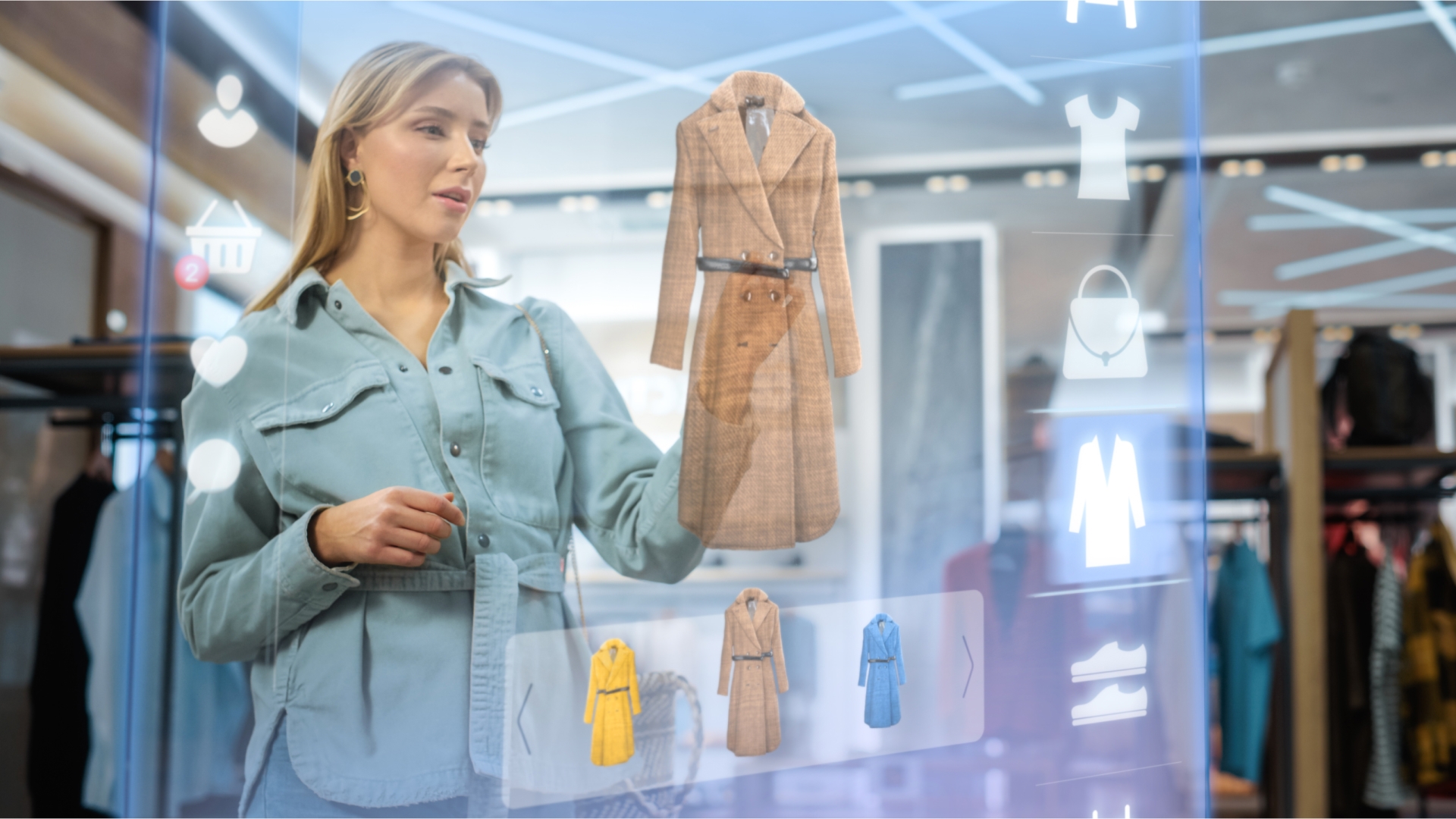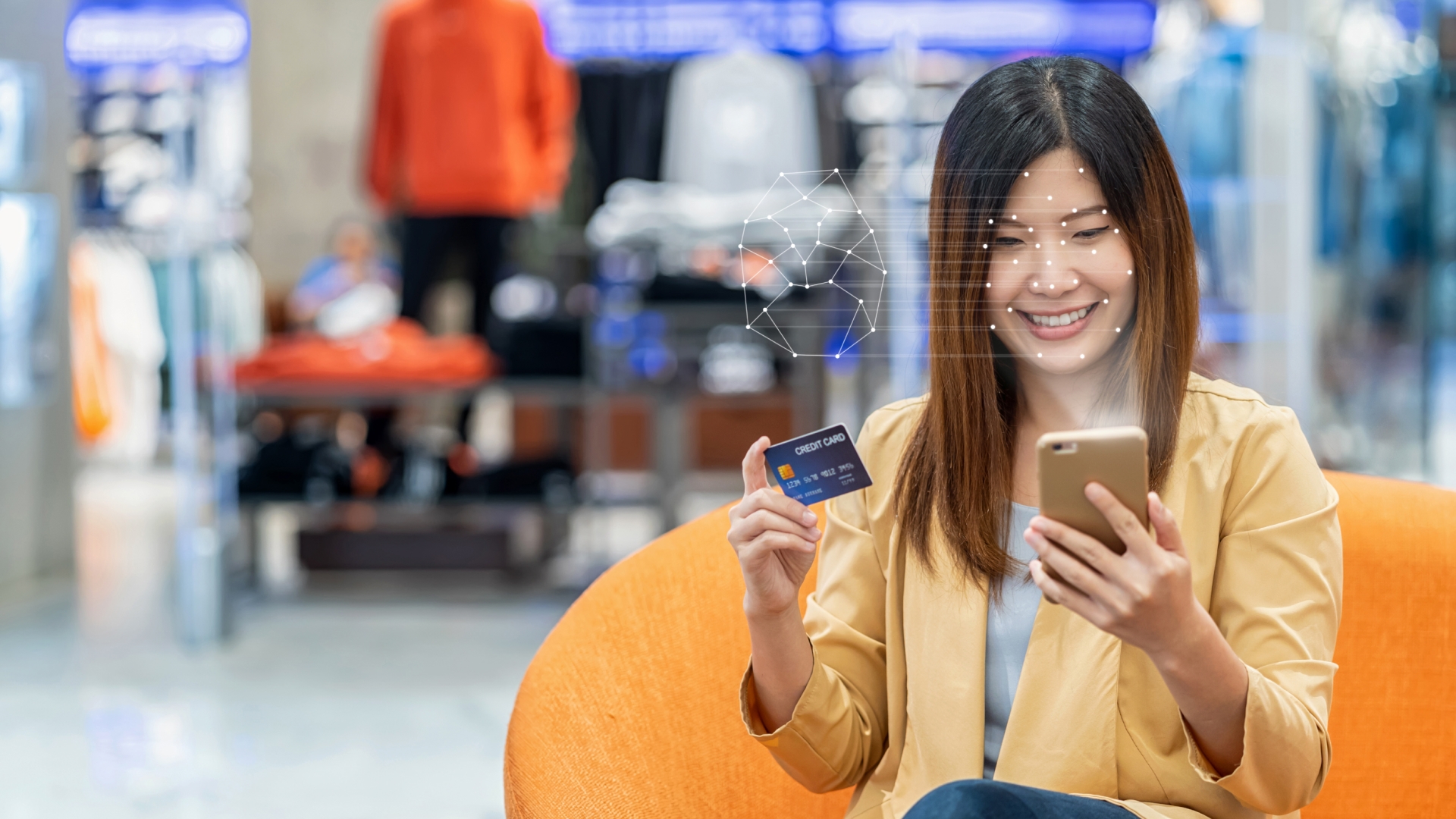Where Bits and Bytes Meet Brick-and-Mortar Retail
As technologies converge and shift retail experiences, consumers still value meaningful interactions with products and people. In-store shopping is increasingly incorporating the best aspects of online commerce.
One Saturday afternoon, after another tough morning on the course, a golfer decides it’s time to upgrade his clubs. As he enters the sporting goods store with his old set, a scanner assesses them, and a phone notification offers him 20% off selected items if he drops off the old clubs for a trade-in. The golfer picks up a putter and a VR headset, and within seconds he’s testing out the putter in a virtual simulator. He earns another 10% discount if he buys the new set of clubs on that visit. He orders the set to be delivered to his home the next day — while still in the simulator.
Meanwhile, across the street, a shopper is trying on a new blazer. The store’s “smart” mirror displays the shopper’s image in all five available colors. A screen embedded in the mirror shows the price for each color and offers delivery of those not in stock. It also offers a lightly used version of the blazer for 20% off. The shopper chooses a blazer and walks out of the store, and their credit card is automatically debited.
The draw of the store
Despite the rapid rise of digital commerce, people still enjoy going to stores and shopping in person. They want to see and feel products, and interact with a social community or lifestyle brand — or just want to get out of the house. The share of retail revenues from digital platforms was at about 15% in the US and 20% globally in 2022, only growing slowly in recent years, demonstrating the persistent appeal of in-store shopping.
“Products are replaceable. Experiences are irreplaceable.”
— Lucia Li, Global Payments Advisory, Consumer Goods and Retail, J.P. Morgan Payments
Stores provide merchants with a unique opportunity to create a memorable experience, says Lucia Li, Global Payments Advisory, Consumer Goods and Retail at J.P. Morgan Payments. “Products are replaceable,” she says. “Experiences are irreplaceable. Forty percent of consumers don’t care where they buy products, so you have to offer them something unique.”
Many of the most intriguing ways to enhance the in-store experience involve bringing the benefits of online shopping — endless choices (including used and refurbished options), personalized recommendations and the chance to collaborate with social peers, influencers and creators — to the in-store world.
This merging of the physical and digital worlds leverages a host of technological advancements. Recent payment innovations help both buyers and sellers focus on the experience, rather than the transaction. They also ensure that sellers can capture value at the moment of the buyer’s purchase decision, whenever or wherever that occurs.

Busting out of the retail box
The growth of omnichannel shopping — in which customers use both offline and online channels on their path to purchase — suggests that consumers are seeking the best of both worlds. Global consultancy Bain & Company predicts an “age of convergence” with the “blending of physical and online channels.”
According to Bain’s December 2022 brief, The Future of Retail: The Age of Convergence, “The future is omnichannel, and retailers will have to push the boundaries of what’s possible to stand out.” The report highlights the importance of retailers getting up to speed with Web3 digital innovations and applications, including blockchain and the metaverse: “These promise huge advances, such as full digitalization and transparency of interactions across channels, as well as the seamless integration of payments.”
Recent payment innovations such as contactless payments — and even checkout-free retail using biometric payments and sensors — have made the in-person shopping experience more convenient. But this is just the beginning of the retail revolution, as the traditional retail model is strained by today’s shifting consumer demands and expectations.
Inspired by online commerce, today’s in-store consumers are asking questions no one had asked before: Why can I only see what’s in stock? Are used or refurbished items available? Can I customize this product or try it out before I buy it? And merchants who have become accustomed to offering dynamic pricing online are asking why they cannot use it offline, as well.
The future of in-store retail
Technology is enabling new retail models that could answer these questions and delight consumers. Here are a few examples of what might be found in stores in the near future:
- Interactive walls of personalized product recommendations, known as “endless aisles."
- Extended-reality labs, where customers use virtual reality (VR) or augmented reality (AR) to try out and purchase products in fun and immersive environments.
- Upcycling zones, where customers can bring used goods for trade, repair or credit.
- AI assistants that offer personalized store tours based on an analysis of shoppers’ social media profiles (if permissioned).
Further down the line, the advance of 3D printing could lead to co-creation tables, where customers are linked to a digital marketplace of products, designs and creators; customers could collaborate with creators to customize products that could be produced in-store in minutes.
Pricing for transactions will become increasingly dynamic, and pricing that customers see on in-store screens may fluctuate, based on factors such as input costs and inventory. For example, the store could offer a shopper an instant discount on an item, based on a real-time analysis of demand. With permission, merchants could identify customers using wireless beacons or other technologies and offer them personalized pricing based on their shopping history and preferences.

New payment structures are key enablers of all these innovations. For example, through embedded or invisible payments, a bank’s financial tools can be integrated seamlessly into a business’s platform, marketplace or connected product. When combined with a digital wallet, embedded payments could allow customers to make purchases directly from a virtual-reality environment, or from an endless aisle.
“Integrating payments can enhance a shopping experience by making it more seamless, fun and memorable,” says Manish Jain, Global Sales Head for Consumer and Retail Industries at J.P. Morgan Payments.
According to J.P. Morgan Payments' Personalized Commerce Trends report, boundaries between online and offline commerce are blurring and merging into an ecosystem that heralds a new era of personalized and frictionless commerce. Offering new, enhanced experiences, this ecosystem will help secure the future of offline retail.
